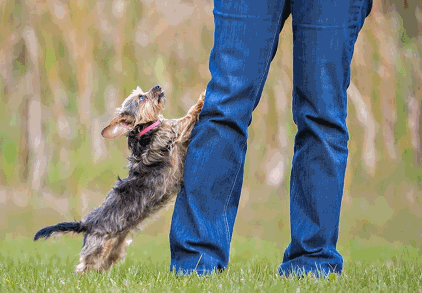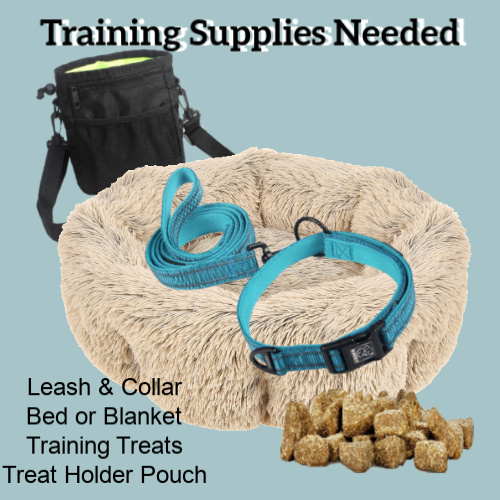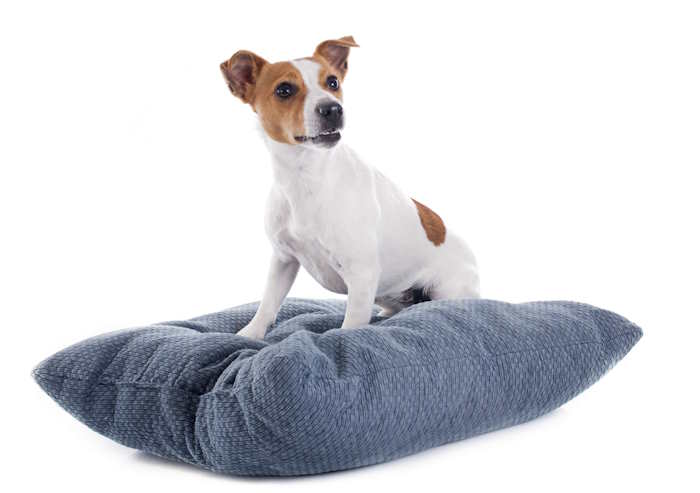Stop a Dog from Jumping By Carlos Garcia |Updated 02-10-2024
Ever walked through your front door only to be bombarded by an overly enthusiastic canine companion? Or you’ve been in the middle of an engaging conversation when, suddenly, your furry friend decides to jump in – quite literally.
It’s a behavior most of us pet owners can relate to but often struggle to curb. Fear not, I’m here to help. Let’s dive into a simple yet effective training program to turn your jumpy pooch into a respectful, well-behaved pet. Ready to embark on this transformation journey? Let’s jump right in!
 How to Stop a Dog from Jumping
How to Stop a Dog from JumpingUnderstanding Your Dog’s Jumping Behavior
There could be several reasons why a dog jumps on people. Here are a few common ones:
1. Excitement: Often, dogs jump on people out of sheer joy and excitement. If a dog perceives someone as a positive presence—someone who gives attention, playtime, or food—it might jump on that person to express happiness and eagerness to interact.
2. Attention-Seeking: Dogs may jump on people to catch their attention. It’s a quick and effective way to get noticed.
3. Greeting: Dogs often jump as a way of greeting. In the dog world, sniffing faces is a common way to say hello, so they might jump on humans to reach our faces and greet us.
4. Dominance: While less common, some dogs might jump on people as a sign of dominance. In a sense, they are trying to show their status in the “pack.”
5. Lack of Training: If a dog isn’t trained to keep all four paws on the ground when humans are around, it might naturally jump.
6. Reward-seeking: If jumping on people in the past has led to rewards for the dog—like treats, pets, or positive attention—it might continue to do so since the behavior has been inadvertently encouraged.
7. High Energy Levels: Dogs with lots of energy may express it through jumping. Regular exercise can often help reduce this behavior by draining their excess energy.
Does there need to be specific commands for each case?
No, there’s no need for separate commands in each situation, as the ultimate objective remains the same. We’ll cover practical obedience because no one wants to ignore their dog all day.
Otherwise, what’s the purpose of having a little dog anyway?
Where and How to Start the Jump-Blocking Training
Keeping things accessible, I focused on one environment: Modification. The most common place where we struggle is at home. Someone walks in, and “Pip” is all over them. Before intervening, your visitor might trip over, step on Pip, or experience other mishaps.
The Key to Successful Training: The ‘Place’ Command
The” place” command is the best choice to stop a little dog from bouncing on humans in your home. The “place” in our training is a dog bed, mat, blanket or any object that your dog can reach entirely on his own.
A benefit to this protocol is that you don’t have to bend down to do it, which enables anyone to do it.
Gathering Your Training Tools
 Supplies needed to teach the dog command, “place.” Leash and Collar ~ Bed or blanket ~ Training Treats ~Treat Holder
Supplies needed to teach the dog command, “place.” Leash and Collar ~ Bed or blanket ~ Training Treats ~Treat Holder- Tiny treats
- A pouch to keep treats handy.
- A target location (such as a pet bed, towel, blanket, etc.)
- Leash and Collar
How to Teach “Place” to Stop a Dog from Jumping
Step-by-Step Guide to Teaching the ‘Place’ Command

To begin this training, get treats and make sure your fur buddy is a little hungry. If he’s picky, use fish or chicken, but cut it into tiny pieces.
Step 1: Nailing Down the Technique: The Food Lure and the Release
First, position yourself & your pet next to the “place” object (pet bed, blanket, etc)
Hold the food to the dog’s nose or further away if he’ll follow it and lead him to the location.
What, He won’t go to your designated “place?”
In that case, toss a couple of treats on it, stand up straight, and ignore him. Let him focus on the reward.
Once he’s on the mat, please give him a treat.
Step 2: Releasing
This step is easy! Just create a little distance, causing him to leave the bed.
Did he stay on? That’s just because he’s associating it with something valuable.
For this, toss a treat on the floor. He’ll be sure to leave his spot.
After this, repeat steps one and two a few times until he’s doing it consistently.
Step 3: Advancing the Training: Introducing Verbal Commands and Distance
Once “Fido” gets comfy with these last two steps, add the word” Place” before you lure him.
By now, he should look more natural. As with the first step, draw him on the bed again. The only real difference between steps one and two and step three is your use of the word, “Place”
Step 4 Eliminating Hand Movements
For step four, your goal is to fade out the use of your hands. Rather, you use the voice command, “place” and then reward when he’s in the correct, “place.” At first you will point, say “place” and reward.
As you repeat this step, extend your arm just a little less until your dog can go to “place,” with your arm next to your body and your fingers flick outward to get him to obey.
Many people struggle with this simply because they worry.
Don’t worry, do it. Eventually, with enough repetitions, your dog will understand what you want him to do.
Step 5: Adding Some Distance
At this point, “Fido” should quickly go to his spot (place) and hold it for several seconds with your verbal command.
Now, after you give the treat, take a small step back with one foot and quickly return to him with another treat.
Repeat, stepping back with both feet and returning to the original, closer distance.
Before you add more distance, add more time to the one step you have already achieved.
Your goal should be to send your dog to “Place” from across the room when needed.
How much distance will this require?
Practically speaking, get about halfway across the room (unless you have a mansion).
Step 6: Ensuring Consistency: Achieving Reliability in Your Dog’s Behaviors
There’s a lot of fancy-looking dog obedience these days. Perhaps you have observed a dog perform impressive commands for a reward.
Could he do it under intense distractions?
Make sure your dog performs in real-world situations!
To do this, use a 6-foot leash and a flat buckle collar.
What will those do for us?
The 6-foot leash is long enough to give the distance we need but also short enough so you can move your hands fast.
The flat collar is the collar you usually see on a dog in public. It can be plastic, nylon, or leather. It is also connected by a plastic insert or a needle through a hole.
It’s wise to use this collar in case your dog is sensitive.
Most people wouldn’t consider this collar aversive, yet it’s often all you need with a small dog. Your dog already understands” place” and has a good foundation for self-control.
Using a Leash to Send
Your dog is equipped with lead and collar; say” place,” then bring him to the area using your leash.
So then, you can easily send your dog using the leash but also get him to stay there.
Using the Leash for “Stay”
To get him to stay there, gradually take steps from him, but now hold the leash handle.
If you add distance, he steps off, quickly encouraging him back with the leash.
You can get a longer leash or clip two together to add distance.
Also, use both hands on the leash for the right timing. Put one hand on the leash handle and use the other like a zip line (palm up).
Using the Leash for Duration
Besides this, being non-negotiable keeps your dog in the spot for extended periods.
Using the leash, do a couple of repetitions of 15 seconds on” place,” then 30 seconds, minutes at a time, and so on.
Lastly, don’t forget to release it!
Someone walks in, and “Pip” is all over them. Before you know it your visitor trips, steps on Pip, and whatever else is imaginable to man.
Step 7: Testing the Waters: Handling Visitors and Triggers
If you put in the work up to this point, good job.
Now it’s time to prove our little friend for the real thing!
How to Hit His Triggers
Start at the beginning of the jumping scenario. Begin with someone knocking or ringing the doorbell.
Communicate with the person via cell phone
Is your dog already flipping out at this point? Of course, he is. That’s why we’re using the leash!
Have the person stay outside
Say” Place” and follow through as I taught you when they hit the bell.
How to Get Passed the Excitement
Would your dog go nuts again if your decoy rang it a second time? Then, tell the person to stay outside and do it again. You would keep commanding him to the spot.
Be patient with this. It will only be long before the doorbell sounds and your dog remains calm.
Continue Taking it Step-By-Step
Then, you may want to make it just a bit harder.
Have the friend open the door only to close it again, then direct “Cujo” to the mat.
Can you see where this is going? It won’t be long before he generalizes, and it gets easier.
Dealing with Tougher Cases: Additional Training Tips for Stubborn Dogs
Some dogs can be more persistent, less sensitive, demanding, you name it!
I get that!
There are also safe, small training collars you can use if necessary. One is the micro-pinch Collar.
If you own a breed like a Yorkie or any other breed prone to a weak trachea, it’s highly recommended to seek professional advice.
Last Words
In conclusion, curbing your dog’s jumping behavior doesn’t need to feel impossible. With patience, consistency, and the right training approach, you can help your pet become calmer and more well-behaved when people come knocking.
Remember, you’re not suppressing their enthusiasm; you’re teaching them a more polite way to express it. Don’t forget that every dog learns at their own pace.
Be patient, reward progress, and celebrate their improvements. Now that you have the tools and steps at your fingertips, it’s time to implement them.
Start implementing these tips today and watch your home become a no-jump zone. Take control of your dog’s behaviors and see the fantastic results. You got this!
Author bio: Stop a Dog from Jumping
About Janice (author and voice behind this site)
Having lived with dogs and cats most of her life, Janice served as a veterinary technician for ten years in Maryland and twelve years as a Shih Tzu dog breeder in Ohio.
Her education includes undergraduate degrees in Psychology with a minor in biology, Early Childhood Education, and Nursing, and a master’s in Mental Health Counseling.
She is a lifelong learner, a dog lover, and passionate about the welfare of animals. Her favorite breed for over 50 years has been the Shih Tzu, but she has also lived with poodles, Maltese, Yorkshire Terriers, beagles, English bulldogs, carin terriers, and a Cocker Spaniel.
When not writing, reading, and researching dog-related topics, she likes to spend time with her eight Shih Tzu dogs, husband, and family, as well as knitting and crocheting. She is also the voice behind Miracle Shih Tzu and Smart-Knit-Crocheting
Does This Article Deserve Your Thumbs Up?
We always appreciate your support and encouragement. Your thumbs up means so much to us. Please like this article.
If you find this page or any page on Small Dog Place Helpful, or useful in anyway, I’d love it if you would click the small heart found on the bottom right of each page.
You can also share or bookmark this page — just click on the:

Free Monthly Newsletter
Sign Up for Our Free Newsletter and get our Free Gift to You.
my E-book, The Top 10 Mistakes People Make When Choosing a Dog (and how to avoid them)


